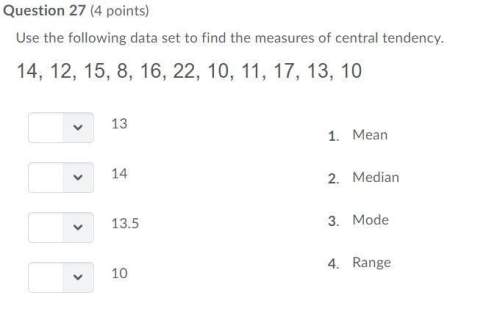
Mathematics, 21.03.2021 09:00 caitlyn73
These are for the exponential function.
What do you need to do to the parent function to make the graph move left? (5
pts.)
• What do you need to do to the parent function to make the graph move right? (5
pts.)
• What do you need to do to the parent function to make the graph move up? (5
pts.)
• What do you need to do to the parent function to make the graph move down? (5
pts.)
• What do you need to do to the parent function to make the graph appear skinnier.
steeper? (5 pts.)
• What do you need to do to the parent function to make the graph fatter, less
steep? (5 pts.)

Answers: 1


Another question on Mathematics

Mathematics, 21.06.2019 15:00
If h(x) = f[tex]h(x) = f[/tex] ° [tex]g) (x)[/tex] and [tex]h(x) = \sqrt[3]{x+3}[/tex], find [tex]g(x)[/tex] if [tex]f(x) = \sqrt[3]{x +2}[/tex] ·
Answers: 1

Mathematics, 21.06.2019 21:30
Design an er diagram for keeping track of information about votes taken in the u.s. house of representatives during the current two-year congressional session. the database needs to keep track of each u.s. state's name (e.g., texas', new york', california') and include the region of the state (whose domain is {northeast', midwest', southeast', southwest', west'}). each congress person in the house of representatives is described by his or her name, plus the district represented, the start date when the congressperson was first elected, and the political party to which he or she belongs (whose domain is {republican', democrat', 'independent', other'}). the database keeps track of each bill (i.e., proposed law), including the bill name, the date of vote on the bill, whether the bill passed or failed (whose domain is {yes', no'}), and the sponsor (the congressperson(s) who sponsored - that is, proposed - the bill). the database also keeps track of how each congressperson voted on each bill (domain of vote attribute is {yes', no', abstain', absent'}). additional information:
Answers: 1

Mathematics, 22.06.2019 01:20
1. why is a frequency distribution useful? it allows researchers to see the "shape" of the data. it tells researchers how often the mean occurs in a set of data. it can visually identify the mean. it ignores outliers. 2. the is defined by its mean and standard deviation alone. normal distribution frequency distribution median distribution marginal distribution 3. approximately % of the data in a given sample falls within three standard deviations of the mean if it is normally distributed. 95 68 34 99 4. a data set is said to be if the mean of the data is greater than the median of the data. normally distributed frequency distributed right-skewed left-skewed
Answers: 2

Mathematics, 22.06.2019 02:40
Jenny made a scale drawing of a city. the scale she used was 5 inches = 1 yard. what is the scale factor of the drawing?
Answers: 3
You know the right answer?
These are for the exponential function.
What do you need to do to the parent function to make the g...
Questions


Mathematics, 09.07.2019 02:50





History, 09.07.2019 02:50


Social Studies, 09.07.2019 02:50

Mathematics, 09.07.2019 02:50





English, 09.07.2019 02:50




Mathematics, 09.07.2019 02:50




